Papers by María I. Micheletti
The Pierre Auger Collaboration: J. Abraham; Abreu, P.; Aglietta, M.; Aguirre, C.; Ahn, EJ; Allard... more The Pierre Auger Collaboration: J. Abraham; Abreu, P.; Aglietta, M.; Aguirre, C.; Ahn, EJ; Allard, D.; Allekotte, I.; Allen, J.; Alvarez-Muñiz, J.; Ambrosio, M.; Anchordoqui, L.; Andringa, S.; Anzalone, A.; Aramo, C.; Arganda, E.; Argirò, S.; Arisaka, K.; Arneodo, F.; Arqueros, F.; Asch, T.; Asorey, H.; Assis, P.; Aublin, J.; Ave, M.; Avila, G.; Bäcker, T.; Badagnani, D.; Barber, KB; Barbosa, AF; Barroso, SLC; Baughman, B.; Bauleo, P.; Beatty, JJ; Beau, T.; Becker, BR; Becker, KH; Bellétoile, A.; Bellido, JA; BenZvi, S.; Berat, C.; Bernardini, ...
Technical reports on operations and features of the Pierre Auger Observatory, including ongoing a... more Technical reports on operations and features of the Pierre Auger Observatory, including ongoing and planned enhancements and the status of the future northern hemisphere portion of the Observatory. Contributions to the 31st International Cosmic Ray Conference, Lodz, Poland, July 2009.
Proceedings of 27th European Cosmic Ray Symposium — PoS(ECRS)
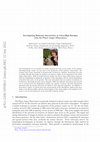
HAL (Le Centre pour la Communication Scientifique Directe), Mar 19, 2022
The development of an extensive air shower depends not only on the nature of the primary ultra-hi... more The development of an extensive air shower depends not only on the nature of the primary ultra-high-energy cosmic ray but also on the properties of the hadronic interactions. For energies above those achievable in human-made accelerators, hadronic interactions are only accessible through the studies of extensive air showers, which can be measured at the Pierre Auger Observatory. With its hybrid detector design, the Pierre Auger Observatory measures both the longitudinal development of showers in the atmosphere and the lateral distribution of particles that arrive at the ground. This way, observables that are sensitive to hadronic interactions at ultra-high energies can be obtained. While the hadronic interaction cross-section can be assessed from the longitudinal profiles, the number of muons and their fluctuations measured with the ground detectors are linked to other physical properties. In addition to these direct studies, we discuss here how measurements of the atmospheric depth of the maximum of air-shower profiles and the characteristics of the muon signal at the ground can be used to test the self-consistency of the post-LHC hadronic models.
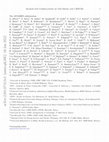
The Astrophysical Journal
For several decades, the origin of ultra-high-energy cosmic rays (UHECRs) has been an unsolved qu... more For several decades, the origin of ultra-high-energy cosmic rays (UHECRs) has been an unsolved question of high-energy astrophysics. One approach for solving this puzzle is to correlate UHECRs with high-energy neutrinos, since neutrinos are a direct probe of hadronic interactions of cosmic rays and are not deflected by magnetic fields. In this paper, we present three different approaches for correlating the arrival directions of neutrinos with the arrival directions of UHECRs. The neutrino data are provided by the IceCube Neutrino Observatory and ANTARES, while the UHECR data with energies above ∼50 EeV are provided by the Pierre Auger Observatory and the Telescope Array. All experiments provide increased statistics and improved reconstructions with respect to our previous results reported in 2015. The first analysis uses a high-statistics neutrino sample optimized for point-source searches to search for excesses of neutrino clustering in the vicinity of UHECR directions. The second...
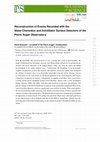
Proceedings of 37th International Cosmic Ray Conference — PoS(ICRC2021)
With the knowledge and statistical power of over a decade and a half of measurements, the Auger C... more With the knowledge and statistical power of over a decade and a half of measurements, the Auger Collaboration has developed, assessed, and refined robust methods for reconstructing the energies and arrival directions of the highest-energy cosmic rays from the signal and timing measurements of its surface detector array. Concurrently, the unearthing of an increasingly complex astrophysical scenario and tensions with hadronic interaction models have demanded the addition of primary mass as an observable measurable using the surface detector. Access to information on the mass hinges on the disentanglement of the electromagnetic and muonic components of extensive air showers. Consequently, an upgrade to the Observatory, AugerPrime, is being carried out by equipping existing water-Cherenkov stations with a 3.8 m 2 Scintillator Surface Detector (SSD). The SSDs, with their high sensitivity to electrons and positrons, will provide samples of the lateral distribution of particles at the ground that complement those of the water-Cherenkov detectors, which are significantly more sensitive to muons. When used together, the two measurements enable extraction of the number of incident muons, which is a quantity that strongly correlates with primary mass. We describe the reconstruction methods being developed for application to measurements of the surface detector of the Observatory with a particular focus on the enhancement of these methods with data of the SSDs of AugerPrime. Results from the reconstruction of thousands of high-energy events already measured with deployed SSDs are also shown.

Proceedings of 37th International Cosmic Ray Conference — PoS(ICRC2021), 2021
Multimessenger astronomy has become increasingly important during the past decade. Some astronomi... more Multimessenger astronomy has become increasingly important during the past decade. Some astronomical objects have already been successfully observed in the light of multiple messenger signals, allowing for a much deeper understanding of their physical properties. The Pierre Auger Observatory has taken part in multimessenger astronomy with an exhaustive exploration of the ultra-high-energy sky. In this contribution, for the first time, a search for UHE photons from the sources of gravitational waves is presented. Interactions with the cosmic background radiation fields are expected to attenuate any possible flux of ultra-high-energy photons from distant sources and a non-negligible background of air shower events with hadronic origin makes an unambiguous identification of primary photons a challenging task. In the analysis presented here, a selection strategy is applied to both GW sources and air shower events aiming to provide maximum sensitivity to a possible photon signal. At the same time, a window is kept open for hypothetical new-physics processes, which might allow for much larger interaction lengths of photons in the extragalactic medium. Preliminary results on the UHE photon fluence from a selection of GW sources, including the binary neutron star merger GW170817 are presented.
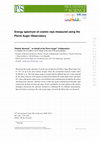
Proceedings of 37th International Cosmic Ray Conference — PoS(ICRC2021), 2021
We present the energy spectrum of cosmic rays measured at the Pierre Auger Observatory from 6 × 1... more We present the energy spectrum of cosmic rays measured at the Pierre Auger Observatory from 6 × 10 15 eV up to the most extreme energies where the accumulated exposure reaches about 80 000 km 2 sr yr. The wide energy range is covered with five different data sets: events detected by the surface detector (with separate reconstruction methods for zenith angles below and above 60 •), those collected by a denser array, a set of hybrid events simultaneously recorded by the surface and fluorescence detectors, and those events in which the signal is dominated by Cherenkov light registered by the high-elevation telescopes. In this contribution, we report updates of the analysis techniques and present the spectrum obtained by combining the five different measurements. Spectral features occurring in the wide energy range covered by the Observatory are discussed.
Proceedings of 37th International Cosmic Ray Conference — PoS(ICRC2021), 2021
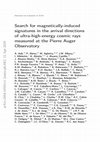
Journal of Cosmology and Astroparticle Physics, 2020
We search for signals of magnetically-induced effects in the arrival directions of ultra-high-ene... more We search for signals of magnetically-induced effects in the arrival directions of ultra-high-energy cosmic rays detected at the Pierre Auger Observatory. We apply two different methods. One is a search for sets of events that show a correlation between their arrival direction and the inverse of their energy, which would be expected if they come from the same point-like source, they have the same electric charge and their deflection is relatively small and coherent. We refer to these sets of events as "multiplets". The second method, called "thrust", is a principal axis analysis aimed to detect the elongated patterns in a region of interest. We study the sensitivity of both methods using a benchmark simulation and we apply them to data in two different searches. The first search is done assuming as source candidates a list of nearby active galactic nuclei and starburst galaxies. The second is an all-sky blind search. We report the results and we find no statistically significant features. We discuss the compatibility of these results with the indications on the mass composition inferred from data of the Pierre Auger Observatory.
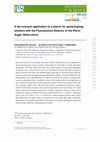
Proceedings of 37th International Cosmic Ray Conference — PoS(ICRC2021), 2021
Recent observations of two coherent radio pulses with the ANITA detector can be interpreted as st... more Recent observations of two coherent radio pulses with the ANITA detector can be interpreted as steeply upward-going cosmic-ray showers with energies of a few tenths of an EeV and remain unexplained. The Pierre Auger Observatory has a large exposure to such upward propagating shower-like events, and has used 14 years of its Fluorescence Detector (FD) data to perform a generic search for such events with elevation angles greater than 20 • from the horizon. Here this search is recast to constrain models generating high energy-leptons. For maximal flexibility, only the propagation, decay, and interactions of-leptons are treated in this analysis, meaning that the results are independent of the-production scenario. This treatment allows for the application of these results to the wide range of models producing-leptons that have been proposed to describe the "anomalous" ANITA events. The goal of this study is accomplished by generating-leptons within the Earth and its atmosphere with an intensity dependent on the media density. The zenith angle, location and calorimetric energy of any resulting-induced air showers are then used to calculate the exposure of the FD of the Pierre Auger Observatory to primaries. Differential limits as low as 10 −9 GeV s −1 cm −2 sr −1 to the flux of-leptons produced with less than a 50 km path length below the Earth's surface are reported for several zenith angle ranges and primary energy spectra. Full exposure and sensitivity information is provided, facilitating the application of these results to different-lepton production models.
Physical Review Letters, 2020
We report a measurement of the energy spectrum of cosmic rays above 2.5 × 10 18 eV based on 215 0... more We report a measurement of the energy spectrum of cosmic rays above 2.5 × 10 18 eV based on 215 030 events. New results are presented: at about 1.3 × 10 19 eV, the spectral index changes from Published by the American Physical Society under the terms of the Creative Commons Attribution 4.0 International license. Further distribution of this work must maintain attribution to the author(s) and the published article's title, journal citation, and DOI.
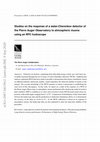
Journal of Instrumentation, 2020
Extensive air showers, originating from ultra-high energy cosmic rays, have been successfully mea... more Extensive air showers, originating from ultra-high energy cosmic rays, have been successfully measured through the use of arrays of water-Cherenkov detectors (WCDs). Sophisticated analyses exploiting WCD data have made it possible to demonstrate that shower simulations, based on different hadronic-interaction models, cannot reproduce the observed number of muons at the ground. The accurate knowledge of the WCD response to muons is paramount in establishing the exact level of this discrepancy. In this work, we report on a study of the response of a WCD of the Pierre Auger Observatory to atmospheric muons performed with a hodoscope made of resistive plate chambers (RPCs), enabling us to select and reconstruct nearly 600 thousand single muon trajectories with zenith angles ranging from 0 • to 55 •. Comparison of distributions of key observables between the hodoscope data and the predictions of dedicated simulations allows us to demonstrate the accuracy of the latter at a level of 2%. As the WCD calibration is based on its response to atmospheric muons, the hodoscope data are also exploited to show the long-term stability of the procedure. K : Large detector systems for particle and astroparticle physics, Data processing methods, Large detector-systems performance, Performance of High Energy Physics Detectors
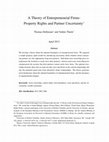
The Astrophysical Journal, 2020
Results of a search for ultra-high-energy neutrinos with the Pierre Auger Observatory from the di... more Results of a search for ultra-high-energy neutrinos with the Pierre Auger Observatory from the direction of the blazar TXS 0506+056 are presented. They were obtained as part of the follow-up that stemmed from the detection of high-energy neutrinos and gamma rays with IceCube, Fermi-LAT, MAGIC, and other detectors of electromagnetic radiation in several bands. The Pierre Auger Observatory is sensitive to neutrinos in the energy range from 100 PeV to 100 EeV and in the zenith-angle range from θ = 60° to θ = 95°, where the zenith angle is measured from the vertical direction. No neutrinos from the direction of TXS 0506+056 have been found. The results were analyzed in three periods: one of 6 months around the detection of IceCube-170922 A, coinciding with a flare period of TXS 0506+056, a second one of 110 days during which the IceCube collaboration found an excess of 13 neutrinos from a direction compatible with TXS 0506+056, and a third one from 2004 January 1 up to 2018 August 31, o...
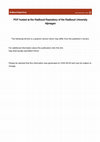
Journal of Cosmology and Astroparticle Physics, 2017
We report a multi-resolution search for anisotropies in the arrival directions of cosmic rays det... more We report a multi-resolution search for anisotropies in the arrival directions of cosmic rays detected at the Pierre Auger Observatory with local zenith angles up to 80 • and energies in excess of 4 EeV (4 × 10 18 eV). This search is conducted by measuring the angular power spectrum and performing a needlet wavelet analysis in two independent energy ranges. Both analyses are complementary since the angular power spectrum achieves a better performance in identifying large-scale patterns while the needlet wavelet analysis, considering the parameters used in this work, presents a higher efficiency in detecting smaller-scale anisotropies, potentially providing directional information on any observed anisotropies. No deviation from isotropy is observed on any angular scale in the energy range between 4 and 8 EeV. Above 8 EeV, an indication for a dipole moment is captured; while no other deviation from isotropy is observed for moments beyond the dipole one. The corresponding p-values obtained after accounting for searches blindly performed at several angular scales, are 1.3 × 10 −5 in the case of the angular power spectrum, and 2.5 × 10 −3 in the case of the needlet analysis. While these results are consistent with previous reports making use of the same data set, they provide extensions of the previous works through the thorough scans of the angular scales.
EPJ Web of Conferences, 2017
We present a combined fit of a simple astrophysical model of UHECR sources to both the energy spe... more We present a combined fit of a simple astrophysical model of UHECR sources to both the energy spectrum and mass composition data measured by the Pierre Auger Observatory. The fit has been performed for energies above 5 EeV, i.e. the region of the all-particle spectrum above the so-called "ankle"' feature. The astrophysical model we adopted consists of identical sources uniformly distributed in a comoving volume, where nuclei are accelerated with a rigidity-dependent mechanism. The fit results suggest sources characterized by relatively low maximum injection energies and hard spectral indices. The impact of various systematic uncertainties on the above result is discussed.
The Astrophysical Journal, 2017
Simultaneous measurements of air showers with the fluorescence and surface detectors of the Pierr... more Simultaneous measurements of air showers with the fluorescence and surface detectors of the Pierre Auger Observatory allow a sensitive search for EeV photon point sources. Several Galactic and extragalactic candidate objects are grouped in classes to reduce the statistical penalty of many trials from that of a blind search and are analyzed for a significant excess above the background expectation. The presented search does not find any evidence for photon emission at candidate sources, and combined p-values for every class are reported. Particle and energy flux upper limits are given for selected candidate sources. These limits significantly constrain predictions of EeV proton emission models from non-transient Galactic and nearby extragalactic sources, as illustrated for the particular case of the Galactic center region.
Physical Review Letters, 2016

Uploads
Papers by María I. Micheletti